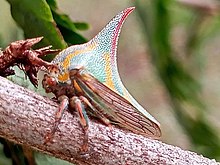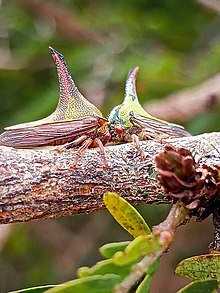| Umbonia spinosa | |
|---|---|

| |
| Umbonia spinosa | |
| Scientific classification | |
| Domain: | Eukaryota |
| Kingdom: | Animalia |
| Phylum: | Arthropoda |
| Class: | Insecta |
| Order: | Hemiptera |
| Suborder: | Auchenorrhyncha |
| Family: | Membracidae |
| Genus: | Umbonia |
| Species: | U. spinosa |
| Binomial name | |
| Umbonia spinosa (Fabricius, 1775) | |
Umbonia spinosa is a species of treehopper native to South America. It belongs to the Membracidae family.
Morphology

Umbonia spinosa can be distinguished from other members of its genus by the appearance of its elongated pronotum, or dorsal horn. The dorsal horn is located between or just behind its humerals and they possess a short metopidium. The dorsal horn itself is straight and the base of the plate is yellow, testaceous or pale green, with red or yellow vittae (stripes) at each side, though sometimes U. spinosa can be characterized by black vittae. It also has an interesting egg survival technique, where “females dig the nest, during the nesting cycle”. The dorsal horn gradually tapers to a point from base to summit, similar to a thorn in appearance.
Distribution and diet
Umbonia spinosa has been found in South and Central America, Mexico, and southern Florida. In general, they tend to reside in more subtropical environments. In Central America, they congregate on the branches of the Persian silk tree (Albizia julibrissin) for mating and overwintering, and are also found on the bean tree (Inga edulis). Female Umbonia spinosa uses those trees to lay their eggs in by making round holes in them. The trees are also used as a source of food, the Umbonia spinosa uses its mouth parts to ingest sap from the trees.
Relationship with humans
The juvenile form of Umbonia spinosa is historically considered edible by the indigenous peoples of South America, while their spines are still soft after molting.

References
- Buys, Sandor C. (Jan 2014). "Behavioural and biological notes on Crabronidae (Hymenoptera: Apoidea) and new geographic records to the Espírito Santo State (Southeast Brazil) Homoptera)". Boletim do Museu de Biologia Mello Leitão. 33 (1): 19–24. JSTOR 25077221.
- Goding, Frederic W. (Sep 1929). "The Membracidae of South America and the Antilles. IV. Subfamilies Hoplophorioninae, Darninae, Smiliinae, Tragopinae (Homoptera)". Transactions of the American Entomological Society. 55 (3): 197–330. JSTOR 25077221.
- ^ Onore, Giovanni (1997). "A brief note on edible insects in Ecuador". Ecology of Food and Nutrition. 36 (2–4): 277–285. doi:10.1080/03670244.1997.9991520. ISSN 0367-0244.
- Martorell, Luis F. (1939). "INSECTS OBSERVED IN THE STATE OF ARAGUA, VENEZUELA, SOUTH AMERICA". The Journal of Agriculture of the University of Puerto Rico. 23 (4): 192. doi:10.46429/jaupr.v23i4.14361. S2CID 246314213.
- Cocroft, Rex (1999). "Thornbug to thornbug". Natural History. 8: 52–56.
- Wallace, Alfred Russel (1854). "On the Insects used for Food by the Indians of the Amazon". Transactions of the Entomological Society of London. 2. 2 (8): 241–244. doi:10.1111/j.1365-2311.1854.tb02224.x. ISSN 0035-8894.
External links
 Media related to Umbonia spinosa at Wikimedia Commons
Media related to Umbonia spinosa at Wikimedia Commons
| Taxon identifiers | |
|---|---|
| Umbonia spinosa | |
This Hemiptera article related to members of the insect suborder Auchenorrhyncha is a stub. You can help Misplaced Pages by expanding it. |